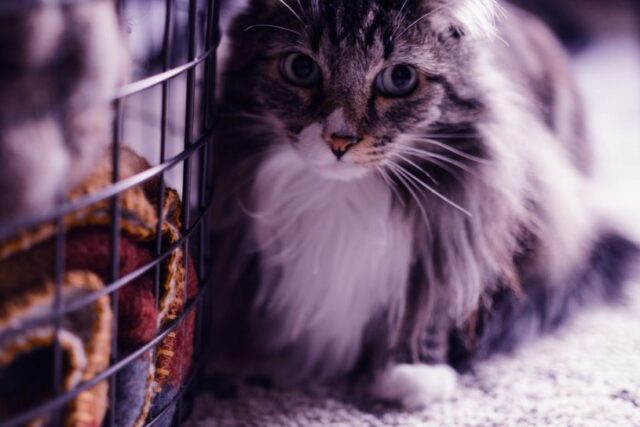As a friendly cat carrier offers your cat an additional sense of protection and may make travel less stressful for both you and your cat, it is an excellent purchase. You and your cat run the risk of injury or death if you don’t use cat travel cages while transporting your cat.
A frightened, free-roaming cat may get inside your automobile like beneath the pedals, in front of the dashboard, or even in the steering wheel. A terrified cat may attack you with her claws, bite you, or otherwise interfere with your ability to drive safely. If your cat isn’t in a carrier, it’s at risk of escaping and being lost or hurt before you have a chance to respond.
Carriers aren’t all created equal. There are many carriers available at the pet shop or online. What factors influence your decision? Cats have a unique viewpoint on the situation. You’ll often find your cats in cardboard boxes, paper bags, and other unconventional containers as they like comfy and dark hiding places. As a result, they feel more secure.
Size Counts!
Cat travel cages must allow cats to stand, sit and turn around. In general, the size of your cat’s carrier should be 1.5 times that of your cat. You may find it challenging to balance and carry the carrier if it is too large. It’s never fun for a cat to travel like they’re on a roller coaster. Your kitten should be transported in a regular-sized container that you believe would be adequate when they are adults. To prevent your kitten from sliding about in the carrier, you should use a thick towel to line the bottom of it.
If you plan on taking your dog on a long road trip, be sure the carrier you choose can hold the dog’s food and water dishes. If you’re going away for a lengthy time, you may select a giant crate that can accommodate a litter box and a bed.
Carrier-pooling isn’t the best way to save money
Separate carriers for each of your cats are preferable to travelling in a single large carrier in the majority of circumstances. Travelling with a single cat in a big carrier may be difficult and unpleasant. Cramming two cats into a tiny carrier is challenging, awkward, and upsetting. In stressful situations, even cats who are ordinarily quite close might demonstrate aggressiveness towards one another.
Stressed cats may demonstrate aggressiveness to each other in the carrier after a trip to the vet, even if the journey itself was quiet. A hostile incident in the carrier will make it more difficult for a cat to enter into the carrier in the future.
Styles
Cardboard
This is only a means of transportation while you are in town. Cats cannot quickly turn around in most cardboard carriers since they are all the same size. Sure, cats may eat cardboard. It isn’t easy to clean if the cat defecates on it while on the road. In a parking lot or other unsafe situations, a cat might push or pull his way out of the carrier, making it more difficult to lock the entrance.
Soft Carriers
Firm yet pliable materials are often used to make them. Carriers made of solid plastic are more cumbersome. Compared to rigid plastic containers, some are not as strong or supportive. More than one opening may be found on several soft carriers. In addition, they may be more challenging to clean if your cat vomits on them while driving. Cats with a penchant for tearing or wearing out their carriers are concerned. Some cats can get out of the container by squeezing through the zipper.
Carriers in the form of a Rolling Suitcase
Cats like the extra space provided by a carrier; they give the cats a better view of their surroundings. People who have trouble transporting items will appreciate the convenience of a rolling carrier, which allows them to wheel the cat wherever they need to go. Dirty ones are more difficult to clean. Noise and bumpiness might terrify some cats while being rolled on the ground.
So, how do you make your choice?
The carrier should be easy to use and not unnecessary worry. Cleanliness and comfort for the cat should be of primary importance. In addition, it should be safe for use by veterinarians. A trip to the veterinarian’s office is often all that a cat does. Making the carrier your cat’s haven while they’re away from home will help reduce their anxiety. When you put a towel in the bottom of your cat’s carrier, it provides familiar odours, as well as a place for your cat to relax and keep them from sliding about. Using pheromone spray 30 minutes before putting the cat in the carrier may also help calm them down.

Lastest Posts
Education
How machine translation is changing the industry: When to use it and when to avoid it?
Health
EEG Analysis: Technology Connecting the Brain to the Future
Marketing
Advancements in Solar Panel Technology: Illuminating the Path to a Sustainable Future
Lifestyle
How to Build a Capsule Wardrobe: Essentials for Every Man
Lifestyle
Women in the Catholic Church: Roles, Recognition, and Calls for Change
Marketing
Experiential Marketing for Brands: Crafting Unforgettable Consumer Connections
Banking & Finance
Understanding the Case-Shiller Home Price Index and Its Multiple Merits